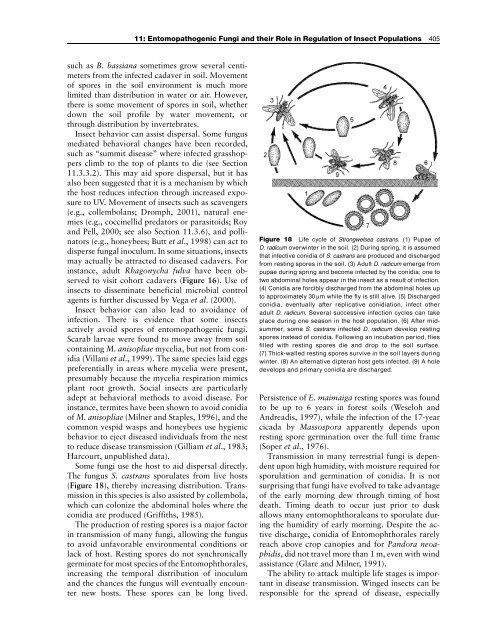Insect Control: Biological and Synthetic Agents - Index of
Insect Control: Biological and Synthetic Agents - Index of
Insect Control: Biological and Synthetic Agents - Index of
You also want an ePaper? Increase the reach of your titles
YUMPU automatically turns print PDFs into web optimized ePapers that Google loves.
11: Entomopathogenic Fungi <strong>and</strong> their Role in Regulation <strong>of</strong> <strong>Insect</strong> Populations 405<br />
such as B. bassiana sometimes grow several centimeters<br />
from the infected cadaver in soil. Movement<br />
<strong>of</strong> spores in the soil environment is much more<br />
limited than distribution in water or air. However,<br />
there is some movement <strong>of</strong> spores in soil, whether<br />
down the soil pr<strong>of</strong>ile by water movement, or<br />
through distribution by invertebrates.<br />
<strong>Insect</strong> behavior can assist dispersal. Some fungus<br />
mediated behavioral changes have been recorded,<br />
such as ‘‘summit disease’’ where infected grasshoppers<br />
climb to the top <strong>of</strong> plants to die (see Section<br />
11.3.3.2). This may aid spore dispersal, but it has<br />
also been suggested that it is a mechanism by which<br />
the host reduces infection through increased exposure<br />
to UV. Movement <strong>of</strong> insects such as scavengers<br />
(e.g., collembolans; Dromph, 2001), natural enemies<br />
(e.g., coccinellid predators or parasitoids; Roy<br />
<strong>and</strong> Pell, 2000; see also Section 11.3.6), <strong>and</strong> pollinators<br />
(e.g., honeybees; Butt et al., 1998) can act to<br />
disperse fungal inoculum. In some situations, insects<br />
may actually be attracted to diseased cadavers. For<br />
instance, adult Rhagonycha fulva have been observed<br />
to visit cohort cadavers (Figure 16). Use <strong>of</strong><br />
insects to disseminate beneficial microbial control<br />
agents is further discussed by Vega et al. (2000).<br />
<strong>Insect</strong> behavior can also lead to avoidance <strong>of</strong><br />
infection. There is evidence that some insects<br />
actively avoid spores <strong>of</strong> entomopathogenic fungi.<br />
Scarab larvae were found to move away from soil<br />
containing M. anisopliae mycelia, but not from conidia<br />
(Villani et al., 1999). The same species laid eggs<br />
preferentially in areas where mycelia were present,<br />
presumably because the mycelia respiration mimics<br />
plant root growth. Social insects are particularly<br />
adept at behavioral methods to avoid disease. For<br />
instance, termites have been shown to avoid conidia<br />
<strong>of</strong> M. anisopliae (Milner <strong>and</strong> Staples, 1996), <strong>and</strong> the<br />
common vespid wasps <strong>and</strong> honeybees use hygienic<br />
behavior to eject diseased individuals from the nest<br />
to reduce disease transmission (Gilliam et al., 1983;<br />
Harcourt, unpublished data).<br />
Some fungi use the host to aid dispersal directly.<br />
The fungus S. castrans sporulates from live hosts<br />
(Figure 18), thereby increasing distribution. Transmission<br />
in this species is also assisted by collembola,<br />
which can colonize the abdominal holes where the<br />
conidia are produced (Griffiths, 1985).<br />
The production <strong>of</strong> resting spores is a major factor<br />
in transmission <strong>of</strong> many fungi, allowing the fungus<br />
to avoid unfavorable environmental conditions or<br />
lack <strong>of</strong> host. Resting spores do not synchronically<br />
germinate for most species <strong>of</strong> the Entomophthorales,<br />
increasing the temporal distribution <strong>of</strong> inoculum<br />
<strong>and</strong> the chances the fungus will eventually encounter<br />
new hosts. These spores can be long lived.<br />
Figure 18 Life cycle <strong>of</strong> Strongwelsea castrans. (1) Pupae <strong>of</strong><br />
D. radicum overwinter in the soil. (2) During spring, it is assumed<br />
that infective conidia <strong>of</strong> S. castrans are produced <strong>and</strong> discharged<br />
from resting spores in the soil. (3) Adult D. radicum emerge from<br />
pupae during spring <strong>and</strong> become infected by the conidia; one to<br />
two abdominal holes appear in the insect as a result <strong>of</strong> infection.<br />
(4) Conidia are forcibly discharged from the abdominal holes up<br />
to approximately 30 mm while the fly is still alive. (5) Discharged<br />
conidia, eventually after replicative conidiation, infect other<br />
adult D. radicum. Several successive infection cycles can take<br />
place during one season in the host population. (6) After midsummer,<br />
some S. castrans infected D. radicum develop resting<br />
spores instead <strong>of</strong> conidia. Following an incubation period, flies<br />
filled with resting spores die <strong>and</strong> drop to the soil surface.<br />
(7) Thick-walled resting spores survive in the soil layers during<br />
winter. (8) An alternative dipteran host gets infected. (9) A hole<br />
develops <strong>and</strong> primary conidia are discharged.<br />
Persistence <strong>of</strong> E. maimaiga resting spores was found<br />
to be up to 6 years in forest soils (Weseloh <strong>and</strong><br />
Andreadis, 1997), while the infection <strong>of</strong> the 17-year<br />
cicada by Massospora apparently depends upon<br />
resting spore germination over the full time frame<br />
(Soper et al., 1976).<br />
Transmission in many terrestrial fungi is dependent<br />
upon high humidity, with moisture required for<br />
sporulation <strong>and</strong> germination <strong>of</strong> conidia. It is not<br />
surprising that fungi have evolved to take advantage<br />
<strong>of</strong> the early morning dew through timing <strong>of</strong> host<br />
death. Timing death to occur just prior to dusk<br />
allows many entomophthoraleans to sporulate during<br />
the humidity <strong>of</strong> early morning. Despite the active<br />
discharge, conidia <strong>of</strong> Entomophthorales rarely<br />
reach above crop canopies <strong>and</strong> for P<strong>and</strong>ora neoaphidis,<br />
did not travel more than 1 m, even with wind<br />
assistance (Glare <strong>and</strong> Milner, 1991).<br />
The ability to attack multiple life stages is important<br />
in disease transmission. Winged insects can be<br />
responsible for the spread <strong>of</strong> disease, especially










